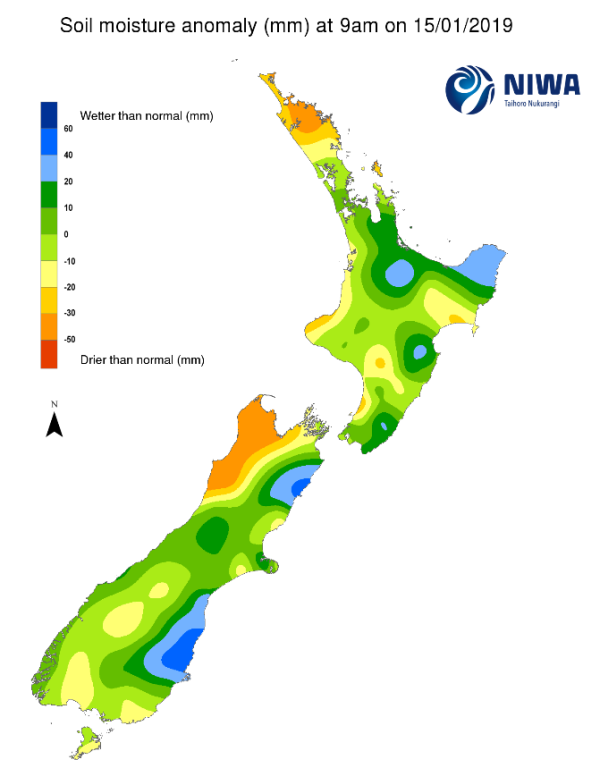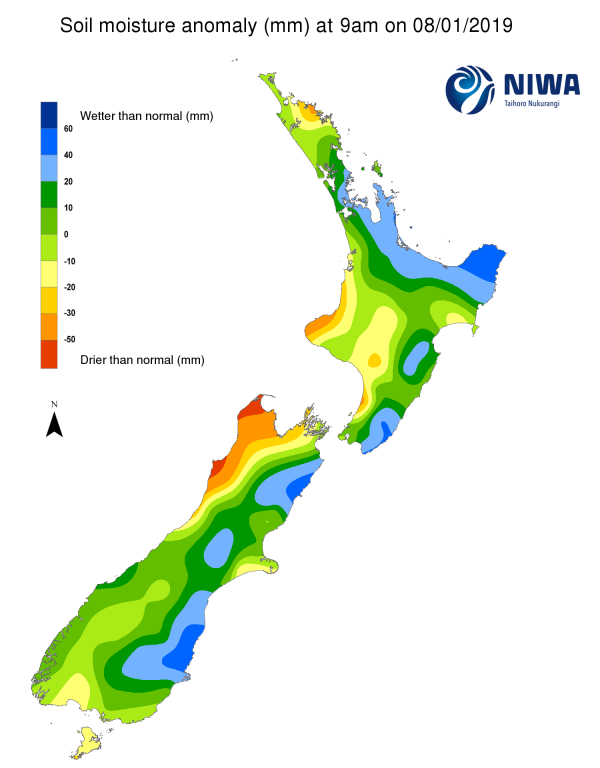A weekly update describing soil moisture across the country to help assess whether severely to extremely dry conditions are occurring or imminent. Regions experiencing these soil moisture deficits are deemed “hotspots”. Persistent hotspot regions have the potential to develop into drought.
Facts: Soil Moisture
Across the North Island, soil moisture levels generally decreased slightly during the past week, with the exception of Northland where the drying was more substantial. Conversely, slight soil moisture improvements were observed in Taranaki. The driest soils across the North Island compared to normal for this time of the year are found in the Far North, while the wettest soils for this time of the year are located in East Cape, interior Bay of Plenty, and a portion of Hastings.
The previous hotspot in the Far North has expanded in size during the past week, now encompassing much of the eastern Far North and the Aupouri Peninsula. Another small hotspot remains in place in Kapiti Coast and coastal Horowhenua.
Across the South Island, soil moisture levels generally decreased slightly in most locations, although small improvements were observed in Tasman and Buller District during the past week. The driest soils across the South Island compared to normal for this time of the year are found in Nelson, Tasman, and Buller District, while the wettest soils for this time of the year are found near Kaikoura and north coastal Otago.
A hotspot remains in place across Nelson and nearby portions of Tasman, but no other South Island hotspots are in effect at this time.
Outlook and Soil Moisture
In the North Island, an area of low pressure off the east coast will continue to bring rainfall primarily to Hawke’s Bay and Gisborne through Thursday morning, where localised amounts around 30 mm will be possible. However, elsewhere in the North Island little if any rainfall will be observed. Mostly dry conditions will persist through the upcoming weekend, although a weak front may produce a few showers for western areas on Sunday (20th January). A couple more weak fronts may produce scattered showers early next week, but rainfall amounts will be meagre. With the exception of the east coast, total rainfall amounts across the North Island in the next week will generally be 10-15 mm, and in the upper North Island amounts could be less than 5 mm.
Due to the meagre rainfall expected in the next week, the current hotspot in the Far North will strengthen and expand across more of Northland, and may enter northern Auckland as well. The hotspot in Kapiti Coast and Horowhenua may also expand slightly, while a new hotspot may form in coastal Taranaki.
A weak front will bring showers to Southland on Thursday, with amounts generally around 10 mm. After a mostly dry Friday, a much more substantial front will deliver significant rainfall to the West Coast, Southland, and Otago on Saturday (19th January). West Coast amounts could approach 75 mm, with up to 25 mm in the Far South. Additional light to moderate rain will occur on Sunday, although Canterbury, Marlborough, and Nelson are likely to miss out on nearly all of this weekend rain. In addition, gusty westerly winds over the weekend and early next week could cause soils in the eastern South Island to dry out rapidly. Another front will reach the West Coast next Wednesday (23rd January) with an additional round of moderate rain west of the divide. Total weekly rainfall for the West Coast could exceed 100 mm, with 30-50 mm for Southland and interior Otago. However, minimal rainfall less than 10 mm is possible for Canterbury, Marlborough, and Nelson.
Due to the expected rainfall, soil moisture levels will increase substantially in the West Coast and Southland during the next week. However, the combination of mostly dry weather and gusty winds could cause rapid decreases for much of the east coast and Nelson. Thus, the current hotspot near Nelson could strengthen in the next week, while central Canterbury may see a new hotspot form in the coming days.
The New Zealand Drought Index (NZDI) map below shows dry to very dry conditions in some coastal areas as of 13 January. This will likely worsen in the North Island and around Nelson in the next week, although some improvement is possible for the West Coast. Please note: some hotspots in the text above may not correspond with the NZDI map, mainly because the NZDI uses additional dryness indices including one which integrates the rainfall deficit over the past 60 days. Changes are therefore slower to appear in the NZDI compared to the instantaneous status maps of soil moisture anomaly.
Background:
Hotspot Watch a weekly advisory service for New Zealand media. It provides soil moisture and precipitation measurements around the country to help assess whether extremely dry conditions are imminent.
Soil moisture deficit: the amount of water needed to bring the soil moisture content back to field capacity, which is the maximum amount of water the soil can hold.
Soil moisture anomaly: the difference between the historical normal soil moisture deficit (or surplus) for a given time of year and actual soil moisture deficits.
Definitions: “Extremely” and “severely” dry soils are based on a combination of the current soil moisture status and the difference from normal soil moisture (see soil moisture maps for more information)



